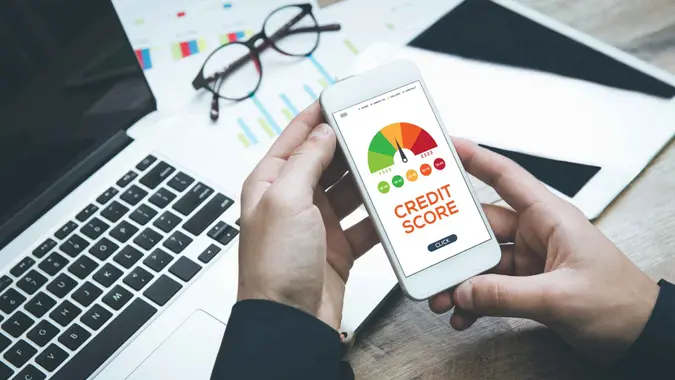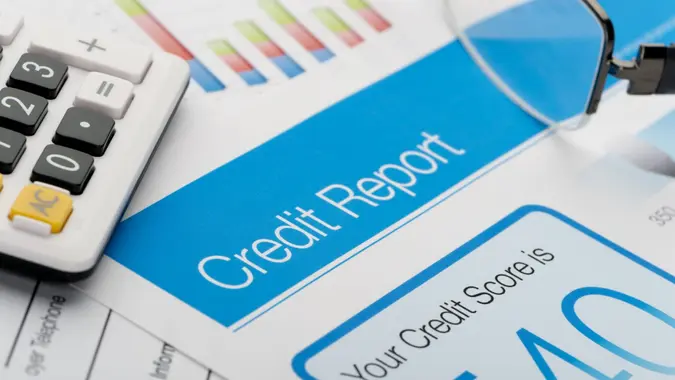How To Check Your Credit Score for Free in 4 Easy Ways

Commitment to Our Readers
GOBankingRates' editorial team is committed to bringing you unbiased reviews and information. We use data-driven methodologies to evaluate financial products and services - our reviews and ratings are not influenced by advertisers. You can read more about our editorial guidelines and our products and services review methodology.

20 Years
Helping You Live Richer

Reviewed
by Experts

Trusted by
Millions of Readers
Checking your credit score isn’t just free, it’s easy, too. Once you sign up for one of the services below, you can check your credit score with just a click.
1. Your Credit Card App
If you have a credit card issued by Chase, Capital One, Discover, Citi® or other major providers, you can check your FICO score or VantageScore for free in the app.
For instance, Capital One’s CreditWise displays your score on the app’s home page, right below your credit card balances and your available rewards. You may have to click to refresh your score.
These apps also alert you if there’s been a change to your score when you log in.
2. Your Bank Account
Most banks and credit unions today display your credit score when you log in to online banking or their app. You can typically refresh the page to see your latest score by clicking the score.
3. Free Credit Apps
If you don’t have a credit card or bank account that shares your credit score, you can use a free app like Credit Karma or Credit Sesame to access your credit score.
It takes a few minutes to set up an account and you may need to provide personal information including your full name and Social Security number.
Here’s what two popular options provide:
- Credit Karma shows your credit score compiled from information on your TransUnion and Equifax credit reports.
- Credit Sesame displays your credit score from TransUnion only if you have a free account. You can upgrade to Premium to see your scores from all three credit bureaus.
4. Credit Bureaus
All three of the major credit bureaus, TransUnion, Equifax and Experian, will let you view your credit score for free once a year. Be sure to read the terms carefully, as they will try to sell you a membership.
Quick Tip
You might notice that each service shows a slightly different score. The scores may be different because they come from different credit bureaus or because one score is FICO and the other is your VantageScore.
Keeping an eye on multiple scores can help you track your financial health. If you notice one score is much lower than the others, this could indicate incorrect information on a credit report.
What’s the Difference Between Credit Score and Credit Report?
A credit score and credit report both provide insights into your financial situation. A credit report paints a more complete picture, with account details for all your loans and credit card accounts, past and present. Your credit score is more like a snapshot of how well you manage credit.
Here’s a quick overview:
| What You See | Credit Score | Credit Report |
|---|---|---|
| 3-digit number? | ✅ Yes | ❌ No |
| Full account details? | ❌ No | ✅ Yes |
| Shows missed payments? | ✅ Yes | ✅ Yes |
| Shows credit inquiries? | ✅ Yes | ✅ Yes |
| How to get it for free | Apps, banks, credit card companies | Once a year at AnnualCreditReport.com |
Good To Know
Checking both your credit score and credit report is smart. Your score tells you how you’re doing, and your report shows why.
Does Checking Your Own Credit Score Hurt It?
Checking your own credit score has no effect on your credit. It is considered a “soft inquiry,” which means it won’t show up on your credit report or hurt your score.
Checking your credit score frequently can alert you to problems, such as high balances, late payments or inaccuracies on your credit report. Try to stay informed and catch problems early.
How Often Should You Check Your Credit Score?
Experts recommend checking your credit score at least once a month, especially if you’re trying to improve your credit. If you use one of the free services listed above, it’s easy to glance at your score whenever you log in to the app.
If you’re applying for a big loan, such as a car loan or mortgage, you might want to check your credit score every few days until you close on the loan. If your score is trending upward, consider ways you can increase it faster, such as by paying down high balances or fixing errors on your credit report.
Pro Tip
If you don’t use your banking or credit card app often, set a calendar reminder. This will help you check your credit score regularly.
What To Do After Checking Your Score
Once you know where you stand, you can take steps to improve your score, whether it’s already close to 800 or under 670.
If your score is in the good to excellent range of 670 or higher:
- You should continue making on-time payments
- Keep your credit utilization below 30%
- As your accounts age, your score will continue to rise
- Keep in mind that if you open a new account, your score may go down temporarily
If your score is under 670, indicating fair or poor credit:
- The first thing you should do is check all three credit reports for mistakes
- You can get each of your credit reports from Experian, Equifax and TransUnion for free once a year at AnnualCreditReport.com
- Your credit report will also show other factors that may be driving down your score, such as accounts in collections, late payments or high balances
- Focus on paying bills on time and reducing your credit utilization by paying down balances
- If you have accounts in collections, take steps to settle that debt
Did You Know?
Even small changes can improve your score. You might see results faster than you think.
Common Myths About Free Credit Scores
Don’t let misinformation keep you from managing your credit wisely. Here are some common myths about credit scores — along with the facts you need to know.
- Myth: Checking hurts your score
- Fact: Checking your own credit does not hurt your credit score. When you apply for a loan or credit card and lenders check your credit, that’s considered a hard inquiry and can reduce your score by a few points for a few months.
- Myth: Free scores aren’t accurate
- Fact: Free credit scores can give you an accurate picture of your financial health. Some free credit services use VantageScore, not FICO, which explains the difference in scores from different services.
- Myth: You only need to check your score before applying for a loan
- Fact: Checking credit regularly can help you spot fraud promptly. It also helps you track your financial progress.
FAQ
Here are the answers to some of the most frequently asked questions about checking credit scores for free.- Where's the best place to check my credit score for free?
- You can check your credit score for free through a variety of services, including your credit card or banking app, Credit Karma and the Experian website.
- Do free credit scores show my real FICO Score?
- Some free credit score services, like Experian, show your FICO Score, while others show VantageScore 3.0, which is another credit score frequently used by lenders.
- Will checking my own score hurt my credit?
- Checking your own credit score is considered a "soft inquiry" and will not hurt your credit.
- How can I check all three credit reports?
- You can check your credit reports from Experian, TransUnion and Equifax for free once a year at AnnualCreditReport.com.
 Written by
Written by  Edited by
Edited by 






















